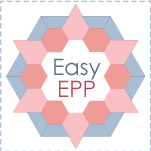The Great Summer Holiday Mystery Quilt #9
'
The Summer Mystery has now finished and the instructions have been removed. However I have left the tutorial here for you as there are a lot of good tips and tricks in the last 10 posts – just use the category to find all posts. You can now download the full pattern as a working Quizzle from here.
Tracey Browning of Constantine Quilts and designer of the pattern you have just made sent me the following notes for quilting the quilt
Quilting
Lay out the backing, wrong side up, and smooth to remove any wrinkles, working on a large flat surface such as the floor. Tape the backing to the floor with packing tape to carpet or masking tape to hard floors. I like to use the carpet as less damage is done to this than my hard floors.
Centre the wadding on top and smooth from the centre outwards.
Place the well pressed pieced top on top of the wadding and backing layers, and smooth out again.
Keeping the layers smooth at all times, pin-baste the quilt in a grid pattern starting from the centre and working towards the edges at a fist width or 4” intervals.
If you are planning to have your quilt machine quilted by a professional then please refer to your quilter for their requirements. Generally, we require a minimum of 3” extra backing and batting all the way around your quilt top to enable us to quilt your quilt on a frame system. You need to supply the top trimmed of all threads & well pressed, the batting & backing squared up/joined etc and then deliver these three pieces to your machine quilter NOT pinned together.
If you would like to quilt your mystery quilt similar to the original Rose Trellis then you will need to be confident with your free-motion machine quilting. I stitched in the ditch the skinny border and all the blocks with a walking foot to stabilize it first then using a free-motion foot quilt a leafy vine design in the outer border, a stylized flower & leafy triangle design in the setting triangles around the outer edge using the design in the fabric to mimic the flower & leaf in there. The centre ‘trellis’ has a ribbon stitched freehand in there as has the skinny border as well. Simply stitch a wavy line that undulates randomly along the fabric then echo back on this line and cross over it every time it changes direction to form a ribbon look.
The large feature fabric squares have been crosshatched 2” apart and the background behind these have a very large stipple – about 1 ½” big that I’ve also echoed back on to create the same ribbon effect. The centre of the stars have also got a flower in them that mimicked the flower in the feature fabric & the setting triangles.
You can see a close up of the quilting on http://quizzles.com.au/components/com_virtuemart/shop_image/product/5-Rose-Trellis.jpg
-------------------------------------------------------------------------------------------
This is how I quilted my version on my Bernina.
I ditched all diagonal straight rows using a walking foot and cream thread.
I ditched both sides of the narrow border then stitched straight lines the width of my foot inside both sides.
I put on my hopping foot and did a freehand continuous rose design in each of the green spot squares and half squares.
I free machined a design around the outside border with matching roses in each corner and then just a vine and leaf design along the sides.
I marked with my ruler and blue washout pen a grid on the large floral squares – I quilted these with my free machine quilt so I didn't have to turn it repeatedly through my little domestic sewing machine. The I did a really large stipple on all of the blue background fabric.
tada…. all quilted. rinse out the blue pen and I will make one final post telling you about binding very soon…
a few other hints and tips from me -
- use a coloured thread that will blend with all your colours. You cant really change threads everytime you move across a different fabric so for me a cream blended quite nicely. Sometimes a mid grey or khaki colour works well or a colour from your fabrics which will contrast nicely with the others in the quilt top.
- I am not too fussy what type of thread I use – but use a quality one, be it 100%cotton, polycotton or even a poly or rayon embroidery thread.
- A patterned backing fabric is great for hiding any imperfections.
- You simply must use a walking foot for your straight line quilting to get a good result.
- I cannot go without my ‘Machingers’ gloves when quilting.
- put some good music on to quilt to and take regular breaks and stretch your shoulders.
- don’t trim your batting and backing fabric to the edge of your quilt top until after quilting when ready to attach the binding.
hugs, Helen
'

2 Item(s)